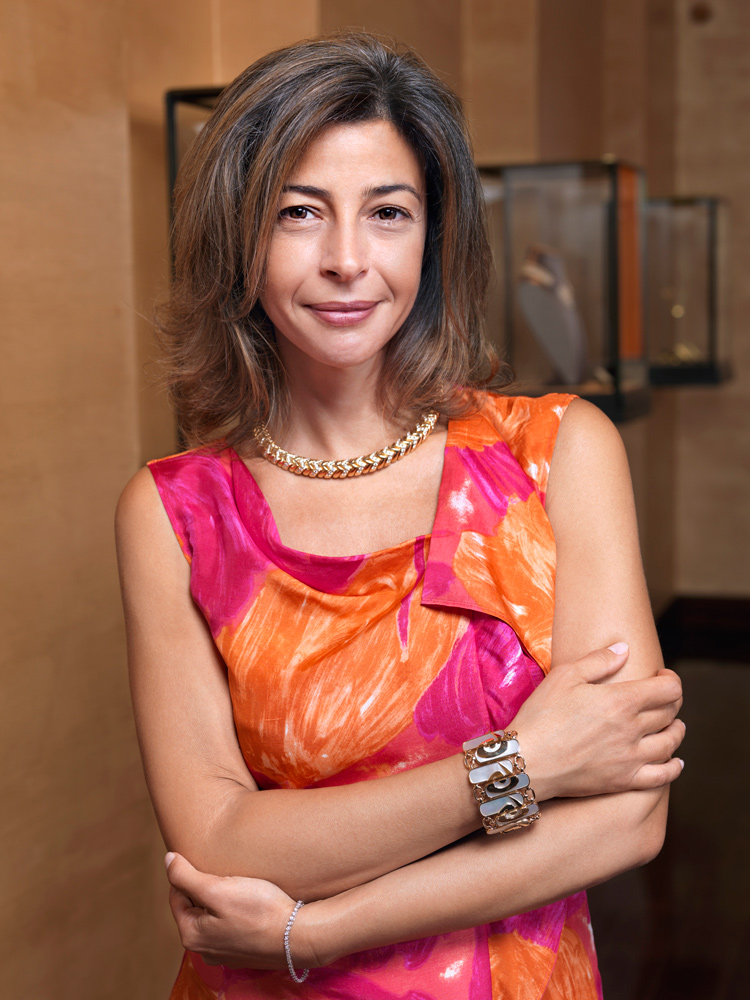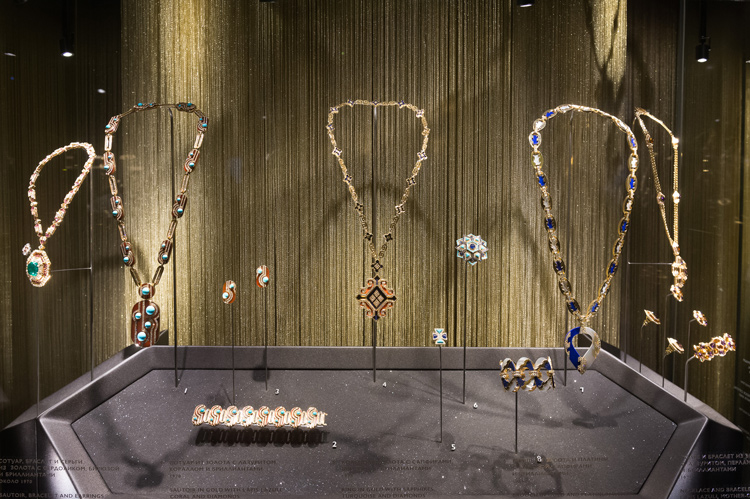As Bvlgari presents a tribute to femininity exhibition in Moscow, we talk to brand and heritage curator Lucia Boscaini who was tasked with bringing all of these iconic jewels together for the first time.
As Bvlgari’s Brand and Heritage Curator Lucia Boscaini has a huge job on her hands. Not only is she responsible for sustaining the image of the Blvgari House she also plays a major role in searching for and buying back iconic pieces of jewellery from the brand’s history.
Many of these pieces are subsequently displayed in exhibitions around the world, helping to showcase and celebrate the legacy of the iconic jewellery House. This fall presents “BVLGARI. Tribute to Femininity” – an exhibition in Russia, presenting some of the House’s most magnificent pieces of jewellery from decades past.
Housed at the Kremlin Museum, the exhibition includes over 500 pieces of jewellery. Lucia Boscaini was the brain behind this beautiful exhibition; bringing together all of these pieces for the first time. Lucia’s job goes further than just organising exhibitions of these pieces – she is also responsible for finding and tracking down these pieces of jewellery from women all over the world, each of whom has a unique story. Here she shares with us her experience, and why this particular project is such an important milestone for the jewellery house.
Can you tell us a little bit about how you put this project together and why you chose this location?
Well the reasons why we wanted to be here is because of the Kremlin Museum has an expertise in jewellery. They have a permanent collection that is really very precious, and in addition to that the directors are experts in jewellery. The last 10-12 years have seen really beautiful jewellery exhibitions here. Also from Bvlgari competitors. The museum has this kind of credibility. So that’s why, when we started planning, and looking for the top museum in the world where Bvlgari would like to be – the Kremlin Museum was really top of the list.
What were the decisions in choosing the pieces that you decided to exhibit?
We have this frame of femininity and a new perspective to go through the archives and the many documents that we have. We sort of re-lived the history of the brand through the women that wore the jewels. This was in a way the easiest way, to start from the movies stars as they are very famous women, but we wanted really to enlarge it much more, and that’s why also in the exhibition you have many pictures of common women, women who are not celebrities or top models, but that are clearly wearing jewels in a way that is very into their time and into the fashion trends of their decades.
In the last few years it came to light the importance of the role of the Heritage Curator – this role has developed to be in the forefront of the Maison – tell us about your role at Bvlgari.
My role is Brand and Heritage Curator, so it’s not only the heritage it is everything. I am part of a larger team that is the marketing and communication team of the company. So I am really into the business side of the company. This is to me my main mission – to protect the identity of the brand in all we do. Then of course to go into detail there are a number of activities: We protect our archive – meaning that we are digitalising it, we keep researching, we keep adding documents; because I’m sure that there are many out there that we do not have yet in our archives, so it is a real research activity. Then we take care of the buy back of the jewels. Jewels are most direct and clear way to tell the identity of the brand.
The collection we have now has a good reach but it is not quite as diverse as we would like. We have a clear strategy in mind, we know the gaps that we have to fill, and so we are working to keep looking for the right jewels for this collection. It’s really quite hard now, because we need exactly a certain type of jewels and it’s not easy, but it is very, very interesting. Meeting people that own the jewels and tracking the stone. There are few records of the past in terms of clients so it is a matter of networking and word of mouth to discover these treasures. For instance, especially in the Middle East, we know that there are many beautiful jewels from historical periods that we are looking for. Jewels from the seventies and eighties but it’s not easy to get in touch with these people. It’s very emotional and it’s a matter of trust as well.
Tell us a story of finding a piece that is part of the collection.
The one that comes to my mind is related to the snake [Serpenti]. We are trying to get connected to owners of jewellery to create trust and then finally convince the to sell or at least to loan us the pieces. And so every now and then we have very small exhibitions of Heritage jewels. One was in Naples during a premiere of a calendar. We had a small exhibition, a few windows with a few jewels. There was also a window with Serpenti on display. A very small old lady came to us and said “they are beautiful jewels, I didn’t know you have these kind of jewels, I had one from my husband a long time ago and I didn’t even know it was Bvlgari.” So we got in touch to visit her and the subject was one of the very first Serpenti from 1954. This was an early design so to us it was extremely interesting to market the evolution of the snake. The proportion and the scales were very differnet in the nineteen fifties. I personally love this piece because the head is very peculiar and the snake has an eyebrow! It is so unusual and to me this is one of the best Serpenti items that we have. The way we got it was so interesting. She was very proud to sell it to us. This is the kind of story that always touches you. There is a lot of human touch in this kind of job – it is quite fun and quite different.
Across history jewellery has always been created to reflect the times – do we still have this these days?
Of course we do – we cannot do it differently. I think in every expression of creativity, be it jewellery, fashion or art – if the creativity is not into the times, it’s not really understandable. It doesn’t work – not in a business perspective but in an emotional perspective. There are of course sometimes designers and artists that are too early for their times. I absolutely believe that each collection is a reflection of time. The jewels that I’m wearing today for instance are completely different from the bold more architectural jewellery because that was a different time. In the seventies it was more recognisable motifs, in the eighties and nineties it was more clean, just a shape that didn’t represent anything it was just a design. So this kind of evolution in style is really going parallel with the evolution of the lifestyle of women.
To what extent is it still crucial that jewellers are revisiting the pillars and archives and reinterpreting – or does it signify a lack of creativity?
To me it’s simply a matter of identity. Each brand has an identity that’s made of different ingredients – the aesthetic codes, the values, the philosophy. To me, to be rooted to the heritage of a brand, it’s really essential in maintaining the identity and making that brand recognisable. If every brand in the luxury world would follow the trends, we would lose our identity. On the contrary, there is an added value of trends but it is about being on time, and in time. The identity that comes from the heritage and the capability to follow and anticipate the trends is what makes brands everlasting.
That’s why for a brand like Bvlgari, heritage is becoming more and more important, because the world today is really fast moving. We have millions of inputs from social media, and if we do not stick to our roots, it’s really a matter of a few months to completely loose the brand equity. And that’s why I absolutely do not believe that going through the heritage is a matter of losing ideas. This is something that looking at the evolution of Bvlgari’s style is so evident. Bvlgari is always trying to combine the roots with the innovation. The tradition is the starting point but it’s always reinterpreted and evolved – that’s really what makes the strength of our brand.
What is it about the Monete emblem and the Serpenti for example that is so timeless and yet still recognisable and desired?
The reason why I believe that still after so many decades those jewels are so appreciated is because they have been there for a long time, but always in new shapes. I think for instance the Monete is extremely interesting because the coins are very rare and are a piece of history but their settings are very modern. When we started with this in the sixties the coins were more classic, and then it became more and more daring. The idea was the same – a contemporary jewel with a piece of history, but it evolved into so many shapes, and that’s why I think it is an exceptional collection. Here in Moscow you can see how the creativity of the jewels with coins is changing and is evolving and can be so different.
BVLGARI. Tribute to Femininity runs until 13th January, 2019 at The Moscow Kremlin Museum.



















